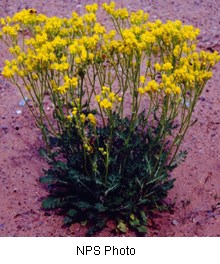
Senecio multilobatus Family: Asteraceae (A Utah Flora – Compositae) – Sunflower Family Perennial, biennial or winter annual herbs from a taproot; stems 3.9” to 2.6' (1 to 8 dm) tall; the juice watery Leaves: alternate and basal; simple (pinnatifid); basal leaves 0.08” to 4.8” (2 to 12 cm) long, 0.12” to 1.4” (0.3 to 3.5 cm) wide; leaves reduced going upwards along stem Flowers: 7 to 13 yellow ray flowers 0.16” to 0.4” (4 to 10 mm) long or lacking; yellow disk flowers, disk 0.24” to 0.6” (6 to 15 mm) wide; involucres 1.6” to 3.6” (4 to 9 cm) high, 0.16” to 0.4” (4 to 10 mm) wide; flower head appears to be a single flower, but is composed of several flowers (a composite) Pollinators: other Senecio species are pollinated by insects Fruits: achene – 1 seeded with hard shell Blooms in Arches National Park: April, May, June, July, August, September, October Habitat in Arches National Park: desert shrub and pinyon-juniper communities Location seen: park road mile 0 to 2.5, Salt Valley Other: The genus name, "Senecio”, is from the Latin “senex” which means “old man” referring to the fine white hairs on the seeds that resemble an old man's beard. The species name, “multilobatus”, means “many-lobed” which describes the leaves. This family is the most advanced and complex of the dicots. The family is rich in oils and resins and is found in every part of the world, but is infrequent in the tropical rainforest. Aquatic or semi-aquatic species are also uncommon. |
Last updated: April 29, 2025
